小学四年级英语教案-Unit2Myschoolbag第二课时
- 格式:docx
- 大小:14.49 KB
- 文档页数:6
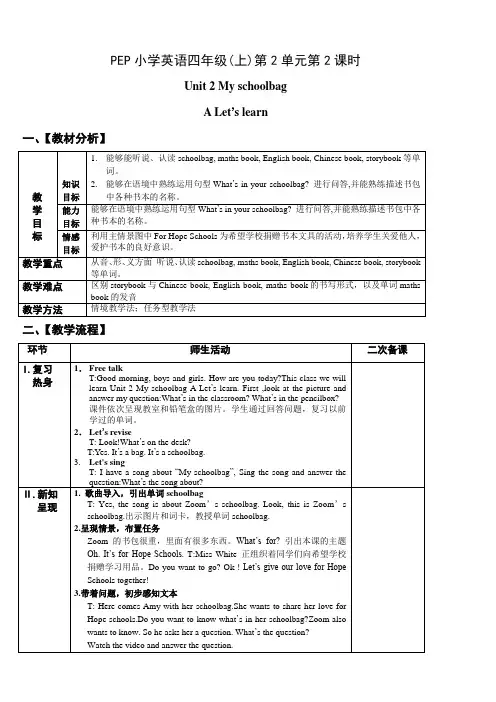
PEP小学英语四年级(上)第2单元第2课时Unit 2 My schoolbagA Let’s learn一、【教材分析】二、【教学流程】长根据同学们的对话内容,做好数量的统计)A: What’s in your schoolbag?B:I have four pens, two storybooks and an English book for Hope Schools.What’s in your schoolbag?C:I have…3.Make a reportThe leader make a report: We have…Ⅴ.总结反馈T:What have we learned in this class?学生用英语或汉语说说本节课学了哪些知识。
Ⅵ.作业布置1.listen to the tape for three times.2.What’s in your schoolbag? Talk about it with your partners.三、【板书设计】Unit 2 My schoolbagA Let’s learnWhat’s in your schoolbag?an English book,a Chinese book,a maths bookthree storybooks四、【教后反思】本节课通过谈论Amy的书包中的物品而呈现了句型“What’s in your schoolbag?”以及schoolbag, maths book, English book, Chinese book和storybook等单词,这部分内容与学生的学习生活息息相关,能激起学生表达的欲望。
因此在设计本节课时,以本单元主情景图中为希望小学捐物这一情境为主要情景,并在这统一的情景下引领学生谈论了Zoom的书包,然后谈论Amy的书包,最后谈论自己的书包,实现了学习语言、操练语言、运用语言等一系列教学目标。
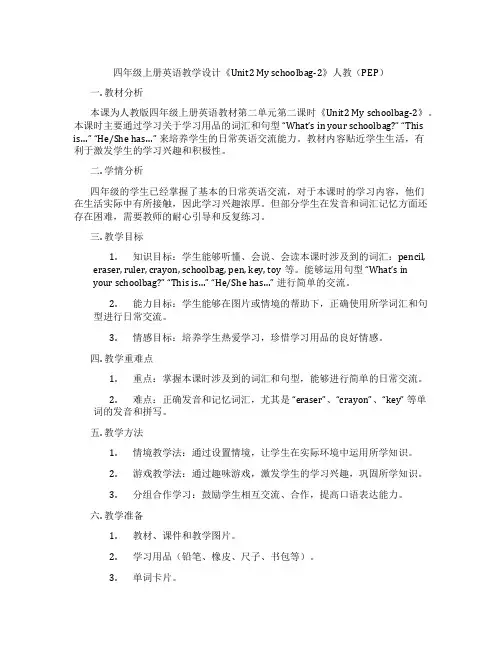
四年级上册英语教学设计《Unit2 My schoolbag-2》人教(PEP)一. 教材分析本课为人教版四年级上册英语教材第二单元第二课时《Unit2 My schoolbag-2》。
本课时主要通过学习关于学习用品的词汇和句型“What’s in your schoolbag?” “This is…” “He/She has…” 来培养学生的日常英语交流能力。
教材内容贴近学生生活,有利于激发学生的学习兴趣和积极性。
二. 学情分析四年级的学生已经掌握了基本的日常英语交流,对于本课时的学习内容,他们在生活实际中有所接触,因此学习兴趣浓厚。
但部分学生在发音和词汇记忆方面还存在困难,需要教师的耐心引导和反复练习。
三. 教学目标1.知识目标:学生能够听懂、会说、会读本课时涉及到的词汇:pencil,eraser, ruler, crayon, schoolbag, pen, key, toy等。
能够运用句型“What’s inyour schoolbag?” “This is…” “He/She has…” 进行简单的交流。
2.能力目标:学生能够在图片或情境的帮助下,正确使用所学词汇和句型进行日常交流。
3.情感目标:培养学生热爱学习,珍惜学习用品的良好情感。
四. 教学重难点1.重点:掌握本课时涉及到的词汇和句型,能够进行简单的日常交流。
2.难点:正确发音和记忆词汇,尤其是“eraser”、“crayon”、“key” 等单词的发音和拼写。
五. 教学方法1.情境教学法:通过设置情境,让学生在实际环境中运用所学知识。
2.游戏教学法:通过趣味游戏,激发学生的学习兴趣,巩固所学知识。
3.分组合作学习:鼓励学生相互交流、合作,提高口语表达能力。
六. 教学准备1.教材、课件和教学图片。
2.学习用品(铅笔、橡皮、尺子、书包等)。
3.单词卡片。
4.录音机、磁带或音频文件。
七. 教学过程1.导入(5分钟)利用歌曲“Hello, Hello, Hello!” 活跃课堂气氛,然后教师提问:“Do you like school? Why?”,引导学生谈论学校生活,为新课的学习做好铺垫。

IntroductionThe Unit 2 of the My schoolbag course for the fourth grade of the primary school is focused on helping children learn English vocabulary related to school supplies. In this lesson, students will learn the words for different writing instruments and how to ask questions and use prepositions to describe their locations. The following article will provide a comprehensive design of the lesson plan, including objectives, materials, activities, assessments, and strategies.ObjectivesAfter completing this lesson, students will be able to achieve the following learning objectives:1.Identify and name different types of writing instruments, suchas pens, pencils, erasers, markers, crayons, and highlighters. e the phrases "What's in your schoolbag?" and "Where ismy/your ___?" to ask and answer questions about the location of different objects.3.Describe the location of objects using prepositions, such as"on," "in," "under," "beside," and "behind."4.Discuss the importance of organization and how to properly packa schoolbag.Materials1.Teacher's edition textbook: My Schoolbag (Unit 2, Lesson 2)2.Student workbooks: My Schoolbag (Unit 2, Lesson 2)3.Writing instruments (pens, pencils, erasers, markers, crayons,and highlighters)4.Flashcards with images of different writing instruments5.Whiteboard and markers6.Schoolbags or backpacks for each studentActivities1.Warm-up activity: Reviewing the vocabulary from the previouslesson, including common school supplies such as notebooks,folders, rulers, and glue.2.Vocabulary introduction: Using flashcards with images ofdifferent writing instruments, introduce and reinforce the names of the different writing instruments.3.Prepositions practice: Ask students to describe the location ofdifferent objects, such as "the pencil is on the desk" or "the eraser is under the book."4.Grammar practice: Practice the phrases "What's in yourschoolbag?" and "Where is my/your ___?" in dialogue.5.Hands-on activity: Allow students to organize their schoolbagsand discuss the importance of organization and packing. Assessments1.Oral assessments: Evaluate students' pronunciation andcomprehension of the vocabulary and grammar introduced in thelesson.2.Written assessments: Provide students with a worksheet or quizcovering the vocabulary and grammar introduced in the lesson.3.Observation assessments: Observe students during the hands-onactivity to ensure they are properly organizing their schoolbags and discussing the importance of organization and packing. Strategies1.Cooperative Learning Strategy: Encourage students to work ingroups to practice speaking and listening skills.2.Differentiated Instruction Strategy: Provide extra support orchallenges for students who may need it.3.Visual Learning Strategy: Use flashcards and visual aids toreinforce learning and engage students.ConclusionOverall, the Unit 2, Lesson 2 of the My Schoolbag course is an important one for fourth-grade students, as they learn essential vocabulary and grammar related to school supplies. By providing them with engaging activities and assessments, teachers can ensure that they achieve the lesson objectives and are well-prepared for future English lessons.。
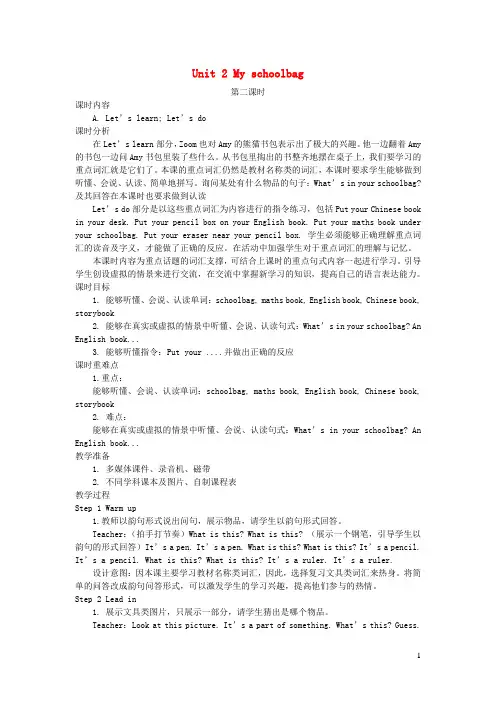
Unit 2 My schoolbag第二课时课时内容A. Let’s learn; Let’s do课时分析在Let’s learn部分,Zoom也对Amy的熊猫书包表示出了极大的兴趣。
他一边翻着Amy 的书包一边问Amy书包里装了些什么。
从书包里掏出的书整齐地摆在桌子上,我们要学习的重点词汇就是它们了。
本课的重点词汇仍然是教材名称类的词汇,本课时要求学生能够做到听懂、会说、认读、简单地拼写。
询问某处有什么物品的句子:What’s in your schoolbag? 及其回答在本课时也要求做到认读Let’s do部分是以这些重点词汇为内容进行的指令练习,包括Put your Chinese book in your desk. Put your pencil box on your English book. Put your maths book under your schoolbag. Put your eraser near your pencil box. 学生必须能够正确理解重点词汇的读音及字义,才能做了正确的反应。
在活动中加强学生对于重点词汇的理解与记忆。
本课时内容为重点话题的词汇支撑,可结合上课时的重点句式内容一起进行学习。
引导学生创设虚拟的情景来进行交流,在交流中掌握新学习的知识,提高自己的语言表达能力。
课时目标1. 能够听懂、会说、认读单词:schoolbag, maths book, English book, Chinese book, storybook2. 能够在真实或虚拟的情景中听懂、会说、认读句式:What’s in your schoolbag? An English book...3. 能够听懂指令:Put your ....并做出正确的反应课时重难点1.重点:能够听懂、会说、认读单词:schoolbag, maths book, English book, Chinese book, storybook2. 难点:能够在真实或虚拟的情景中听懂、会说、认读句式:What’s in your schoolbag? An English book...教学准备1. 多媒体课件、录音机、磁带2. 不同学科课本及图片、自制课程表教学过程Step 1 Warm up1.教师以韵句形式说出问句,展示物品,请学生以韵句形式回答。
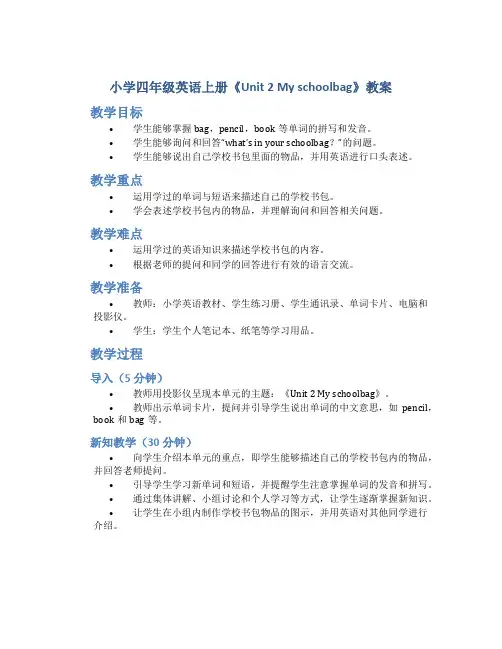
小学四年级英语上册《Unit 2 My schoolbag》教案教学目标•学生能够掌握bag,pencil,book等单词的拼写和发音。
•学生能够询问和回答“what’s in your schoolbag?”的问题。
•学生能够说出自己学校书包里面的物品,并用英语进行口头表述。
教学重点•运用学过的单词与短语来描述自己的学校书包。
•学会表述学校书包内的物品,并理解询问和回答相关问题。
教学难点•运用学过的英语知识来描述学校书包的内容。
•根据老师的提问和同学的回答进行有效的语言交流。
教学准备•教师:小学英语教材、学生练习册、学生通讯录、单词卡片、电脑和投影仪。
•学生:学生个人笔记本、纸笔等学习用品。
教学过程导入(5分钟)•教师用投影仪呈现本单元的主题:《Unit 2 My schoolbag》。
•教师出示单词卡片,提问并引导学生说出单词的中文意思,如pencil,book和bag等。
新知教学(30分钟)•向学生介绍本单元的重点,即学生能够描述自己的学校书包内的物品,并回答老师提问。
•引导学生学习新单词和短语,并提醒学生注意掌握单词的发音和拼写。
•通过集体讲解、小组讨论和个人学习等方式,让学生逐渐掌握新知识。
•让学生在小组内制作学校书包物品的图示,并用英语对其他同学进行介绍。
练习(30分钟)•老师让学生以小组为单位进行问答练习,即随机问一个学生“what’s in your schoolbag?”并要求该学生口头回答,其他学生要在规定时间内记录并完成模仿。
•学生可以相互检查彼此的作业,老师也在此时检查学生们的作业,发现问题并及时纠正。
•老师引导学生进行课堂互动,在学生之间展示学校书包物品并提出问题,并由学生相互解答。
在课堂上建立一个友好的学习氛围,让学生感受到英语学习的乐趣。
总结(5分钟)•教师向学生回顾本次课程的重点知识,送上一些鼓励的话语,帮助学生增强学习动力。
•教师要求学生将学到的新单词和短语写入学习笔记本,并要求学生思考今天学到的语言知识如何与日常生活联系,激发学生兴趣和热情。
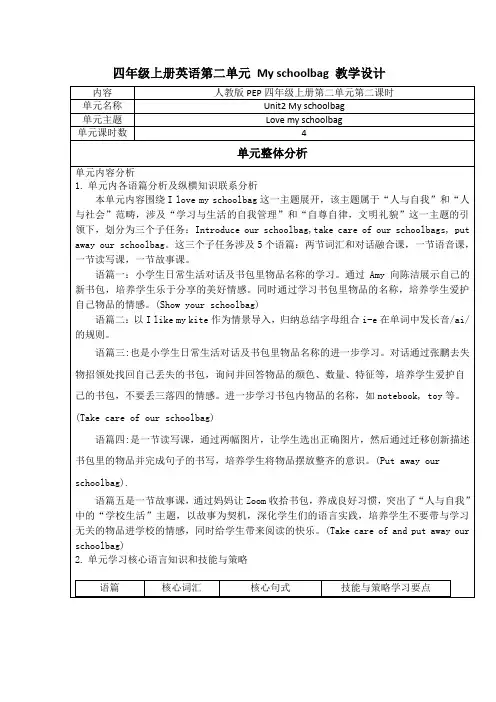
四年级上册英语第二单元My schoolbag 教学设计单元教学目标评价量化表反面评价量化表背面课时教学设计一、语篇分析What:本课语篇是小学生日常生活对话及书包里物品名称的进一步学习。
本语篇描述了张鹏寻找自己丢失的书包的全过程,首先故事的地点发生在失物招领处,张鹏通过向老师有序的描述书包的特征,如颜色、形状、其中的物品等不同特征最终找回了自己丢失的东西。
并对书包内物品进行核查确Why:小学生丢失物品的情况并不少见,语篇内容贴近学生实际生活。
作者通过张鹏寻找丢失书包的过程:go to the Lost&Found描述颜色描述书包中的物品,最终快速找到自己的书包,旨在帮助学生了解如何有序快速的通过描述自己丢失物品的特征来快速找到丢失的物品,以及养成爱护珍惜自己物品的意识。
How:本语篇是以教师与学生的对话形式呈现的语言内容,其明线是张鹏介绍自己丢失的书包特征而暗线则是通过张鹏与教师的对话帮助学生掌握应该如何有逻辑的描述自己物品特征快速找回丢失的物品。
本课语言结构从colour和 What s in?为主要框架展开师生间的对话。
故事及对话特点符合学生实际生活,教师可以充分与学生实际生活相联系,通过本课内容进行再构应用。
3.想象与创编对话,合理安排分工并向全班展示交流结果。
(迁移创新)四、教学评价1.过程性评价(1)评价量表:结合评价量表发挥学生主体地位,推动学生语言能力和学习能力的发展。
教师根据本节课的教学设计,设定多样的评价量表,让学生在评价时更聚焦主题,言之有物,同时也让教学形成闭环反馈,反作用于教学活动设计。
如:Listen and check/Discuss and choose部分的自评表。
自评表(2)随堂评价:1)观察学生的动作、表情并评价,推动学生文化意识和语言能力发展2)听取学生回答的问题并评价,推动学生语言能力和思维品质的发展。
3)乐于愿意发现学生的闪光点,运用多样的表扬课堂用语,激发学生学习英语的主观能动性和积极性。
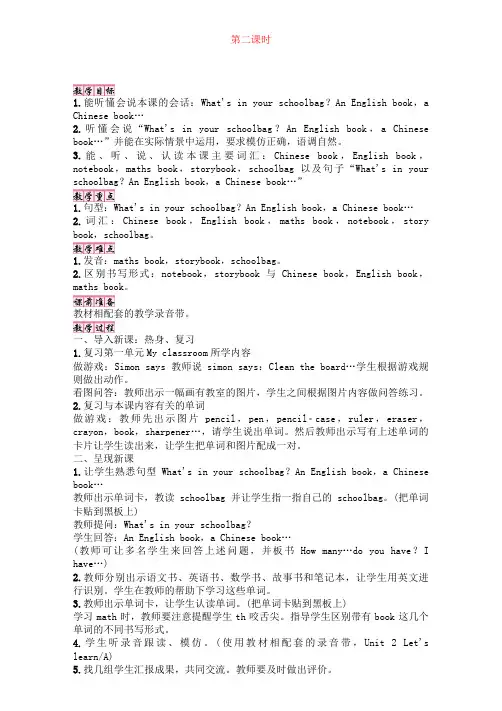
第二课时1.能听懂会说本课的会话:What's in your schoolbag?An English book,a Chinese book…2.听懂会说“What's in your schoolbag?An English book,a Chinese book…”并能在实际情景中运用,要求模仿正确,语调自然。
3.能、听、说、认读本课主要词汇:Chinese book,English book,notebook,maths book,storybook,schoolbag以及句子“What's in your schoolbag?An English book,a Chinese book…”1.句型:What's in your schoolbag?An English book,a C hinese book…2.词汇:Chinese book,English book,maths book,notebook,story book,schoolbag。
1.发音:maths book,storybook,schoolbag。
2.区别书写形式:notebook,storybook与Chinese book,English book,maths book。
教材相配套的教学录音带。
一、导入新课:热身、复习1.复习第一单元My classroom所学内容做游戏:Simon says 教师说simon says:Clean the board…学生根据游戏规则做出动作。
看图问答:教师出示一幅画有教室的图片,学生之间根据图片内容做问答练习。
2.复习与本课内容有关的单词做游戏:教师先出示图片pencil,pen,pencilcase,ruler,eraser,crayon,book,sharpener…,请学生说出单词。
然后教师出示写有上述单词的卡片让学生读出来,让学生把单词和图片配成一对。
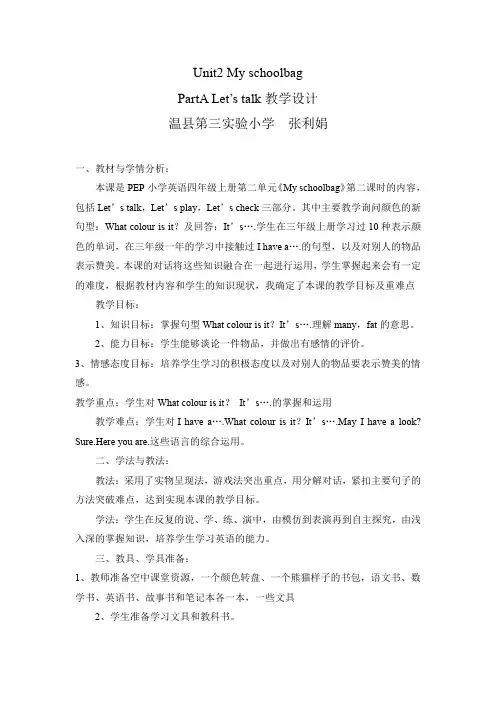
Unit2 My schoolbagPartA Let’s talk教学设计温县第三实验小学张利娟一、教材与学情分析:本课是PEP小学英语四年级上册第二单元《My schoolbag》第二课时的内容,包括Let’s talk,Let’s play,Let’s check三部分。
其中主要教学询问颜色的新句型:What colour is it?及回答:It’s….学生在三年级上册学习过10种表示颜色的单词,在三年级一年的学习中接触过I have a….的句型,以及对别人的物品表示赞美。
本课的对话将这些知识融合在一起进行运用,学生掌握起来会有一定的难度,根据教材内容和学生的知识现状,我确定了本课的教学目标及重难点教学目标:1、知识目标:掌握句型What colour is it?It’s….理解many,fat的意思。
2、能力目标:学生能够谈论一件物品,并做出有感情的评价。
3、情感态度目标:培养学生学习的积极态度以及对别人的物品要表示赞美的情感。
教学重点:学生对What colour is it?It’s….的掌握和运用教学难点:学生对I have a….What colour is it?It’s….May I have a look? Sure.Here you are.这些语言的综合运用。
二、学法与教法:教法:采用了实物呈现法,游戏法突出重点,用分解对话,紧扣主要句子的方法突破难点,达到实现本课的教学目标。
学法:学生在反复的说、学、练、演中,由模仿到表演再到自主探究,由浅入深的掌握知识,培养学生学习英语的能力。
三、教具、学具准备:1、教师准备空中课堂资源,一个颜色转盘、一个熊猫样子的书包,语文书、数学书、英语书、故事书和笔记本各一本,一些文具2、学生准备学习文具和教科书。
四、教学流程:一)、复习旧知,为新课铺垫(Warm up)1、师生日常对话练习(通过师生、生生日常用语的问答交流,自然营造了轻松的英语语言氛围,使之很快进入到英语语言学习的情境来)。
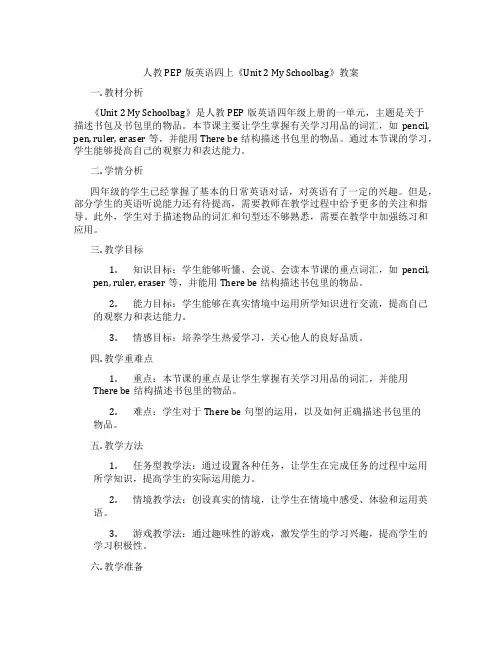
人教PEP版英语四上《Unit 2 My Schoolbag》教案一. 教材分析《Unit 2 My Schoolbag》是人教PEP版英语四年级上册的一单元,主题是关于描述书包及书包里的物品。
本节课主要让学生掌握有关学习用品的词汇,如pencil, pen, ruler, eraser等,并能用There be结构描述书包里的物品。
通过本节课的学习,学生能够提高自己的观察力和表达能力。
二. 学情分析四年级的学生已经掌握了基本的日常英语对话,对英语有了一定的兴趣。
但是,部分学生的英语听说能力还有待提高,需要教师在教学过程中给予更多的关注和指导。
此外,学生对于描述物品的词汇和句型还不够熟悉,需要在教学中加强练习和应用。
三. 教学目标1.知识目标:学生能够听懂、会说、会读本节课的重点词汇,如pencil,pen, ruler, eraser等,并能用There be结构描述书包里的物品。
2.能力目标:学生能够在真实情境中运用所学知识进行交流,提高自己的观察力和表达能力。
3.情感目标:培养学生热爱学习,关心他人的良好品质。
四. 教学重难点1.重点:本节课的重点是让学生掌握有关学习用品的词汇,并能用There be结构描述书包里的物品。
2.难点:学生对于There be句型的运用,以及如何正确描述书包里的物品。
五. 教学方法1.任务型教学法:通过设置各种任务,让学生在完成任务的过程中运用所学知识,提高学生的实际运用能力。
2.情境教学法:创设真实的情境,让学生在情境中感受、体验和运用英语。
3.游戏教学法:通过趣味性的游戏,激发学生的学习兴趣,提高学生的学习积极性。
六. 教学准备1.教具:准备书包、学习用品等实物,以及相关的图片、卡片等。
2.课件:制作课件,包括单词卡片、图片、动画等,以便于教学展示。
七. 教学过程1.导入(5分钟)教师通过提问方式引导学生谈论书包,引出本节课的主题。
例如:“What’s in your schoolbag?”, “Can you show me your pen?”, “Is there a ruler in your schoolbag?”等。
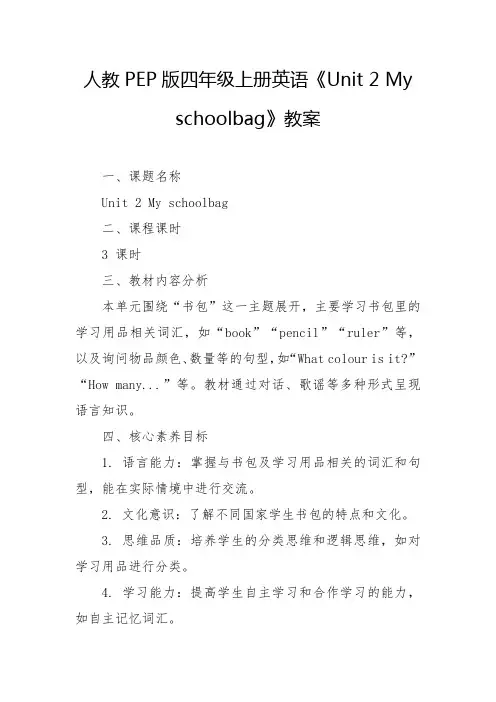
人教PEP版四年级上册英语《Unit 2 Myschoolbag》教案一、课题名称Unit 2 My schoolbag二、课程课时3 课时三、教材内容分析本单元围绕“书包”这一主题展开,主要学习书包里的学习用品相关词汇,如“book”“pencil”“ruler”等,以及询问物品颜色、数量等的句型,如“What colour is it?”“How many...”等。
教材通过对话、歌谣等多种形式呈现语言知识。
四、核心素养目标1. 语言能力:掌握与书包及学习用品相关的词汇和句型,能在实际情境中进行交流。
2. 文化意识:了解不同国家学生书包的特点和文化。
3. 思维品质:培养学生的分类思维和逻辑思维,如对学习用品进行分类。
4. 学习能力:提高学生自主学习和合作学习的能力,如自主记忆词汇。
五、教学重点、难点1. 教学重点掌握重点词汇:schoolbag、book、pencil、ruler、eraser、crayon 等。
掌握重点句型:What's in your schoolbag? What colour is it? How many...do you have?等。
2. 教学难点词汇中一些相似单词的发音区别,如“ruler”和“eraser”。
能够灵活运用句型进行问答交流。
六、课的类型及主要教学方法1. 课的类型:词汇课、对话课、读写课。
2. 主要教学方法:情景教学法、游戏教学法、歌曲教学法。
七、教学过程第一课时1. 导入环节(5 分钟)教学环节:展示一个漂亮的书包。
教师活动:“Hello, boys andgirls. Look at this beautifulschoolbag. What do you think isin it? Today we are going to learn about schoolbags and the things in them.”学生活动:学生们好奇地看着书包,猜测里面有什么物品。
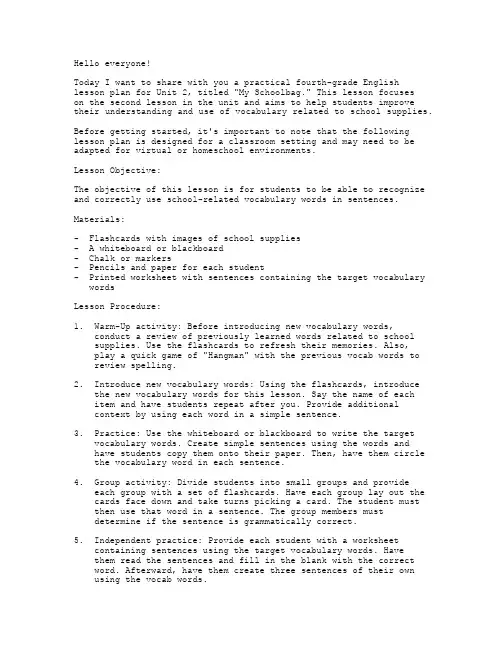
Hello everyone!Today I want to share with you a practical fourth-grade Englishlesson plan for Unit 2, titled "My Schoolbag." This lesson focuseson the second lesson in the unit and aims to help students improve their understanding and use of vocabulary related to school supplies.Before getting started, it's important to note that the following lesson plan is designed for a classroom setting and may need to be adapted for virtual or homeschool environments.Lesson Objective:The objective of this lesson is for students to be able to recognize and correctly use school-related vocabulary words in sentences. Materials:-Flashcards with images of school supplies- A whiteboard or blackboard-Chalk or markers-Pencils and paper for each student-Printed worksheet with sentences containing the target vocabulary wordsLesson Procedure:1.Warm-Up activity: Before introducing new vocabulary words,conduct a review of previously learned words related to schoolsupplies. Use the flashcards to refresh their memories. Also,play a quick game of "Hangman" with the previous vocab words to review spelling.2.Introduce new vocabulary words: Using the flashcards, introducethe new vocabulary words for this lesson. Say the name of eachitem and have students repeat after you. Provide additionalcontext by using each word in a simple sentence.3.Practice: Use the whiteboard or blackboard to write the targetvocabulary words. Create simple sentences using the words andhave students copy them onto their paper. Then, have them circle the vocabulary word in each sentence.4.Group activity: Divide students into small groups and provideeach group with a set of flashcards. Have each group lay out the cards face down and take turns picking a card. The student must then use that word in a sentence. The group members mustdetermine if the sentence is grammatically correct.5.Independent practice: Provide each student with a worksheetcontaining sentences using the target vocabulary words. Havethem read the sentences and fill in the blank with the correctword. Afterward, have them create three sentences of their ownusing the vocab words.6.Wrap-up: Review the target vocabulary words and ask students tosummarize the lesson in their own words. Provide feedback ontheir sentences and encourage them to continue practicing the words throughout the week.With this lesson plan, your students will be able to recognize and use school-related vocabulary words confidently. Remember to keep the lesson engaging and interactive to help students take aninterest in learning the words.I hope you find this lesson plan helpful. Happy teaching!。
Unit 2 My schoolbag第一课时一、教学内容与分析(一)教学内容:A Let’s talk &Let’s play(二)教学目标:1.能够通过观察和谈论Let’s talk板块的图片理解对话大意2.能够用正确的语音、语调及意群朗读对话,并能在小组中进行角色扮演3.能够在情景中运用句型“—What’s in your schoolbag? —An English book…”“I have a new schoolbag. It’s black and white.”4.能够在语境中理解新词“schoolbag, English book, maths book, storybook”的意思,并能够正确发音5.在趣味游戏中运用语言,操练并巩固句型“—What’s in your…? —It’s a/an…”(三)教学重点、难点分析:1.教学重点:(1)能够理解和掌握重点词汇和核心句型。
(2)能够在情景中运用句型“—What’s in your schoolbag? —An English book…”“I have a new schoolbag. It’s black and white.”。
2. 教学难点:能够在语境中灵活运用核心句型。
二、课前准备(一)本课教学相关物品卡片。
(二)多媒体课件。
三、教学步骤(一)热身与复习(Warm-up and Revision)Let’s sing: My schoolbagT:Let’s sing a song together. Stand up, please. Are you ready? Let’s go.(二)呈现与操练(Presentation and Practice)1.Let’s sayT:What can you see in Zoom’s schoolbag?S:I see ...Zoom: My schoolbag is heavy.T:How about your schoolbag ? Is it heavy?S:Yes, it is.//No,it isn’t.2.Watch and answer(1)Q: What are they talking about?A: They are talking about a schoolbag .(2)Q1:What color is Amy’s schoolbag?Q2:What does Amy’s school look like?A1:It’s black and white.A2:It’s a panda.3.Listen and fill(1)Q:What’s in Amy’s schoolbag?(2)Let’s say4.Let’s talk(1)Listen and imitate(2)Listen,repeat and practice(3)Let’s fill(4)Make a new dialogue(三)巩固与操练(consolidation and Extension)Let’s play(1)Let’s guess.T:Look, this is Sarah. Let’s guess what’s in her hand? S:...(2)Play with your partner四、家庭作业(Homework)1. 跟读书P14录音3遍,注意语音语调。
人教PEP版英语四年级上册Unit 2《My schoolbag》教案一. 教材分析人教PEP版英语四年级上册Unit 2《My schoolbag》主要介绍了学生书包里的物品,通过学习本单元,学生能够掌握有关书包、文具、颜色等词汇,以及简单的句子结构。
本单元有利于提高学生对日常生活中的物品的认识,增强他们用英语进行简单交流的能力。
二. 学情分析四年级的学生已经具备了一定的英语基础,能够听、说、读、写简单的英语单词和句子。
他们对生活中的物品有一定的认识,容易理解和掌握相关词汇。
但部分学生可能会对颜色词汇和形容词的用法感到陌生,需要老师在教学中给予重点指导。
三. 教学目标1.知识目标:学生能够掌握有关书包、文具、颜色等词汇,以及简单的句子结构。
2.能力目标:学生能够用英语描述书包里的物品,进行简单交流。
3.情感目标:培养学生热爱生活、关注身边事物的态度。
四. 教学重难点1.重点:学生能够听、说、读、写本单元的生词和句子。
2.难点:学生能够正确运用颜色词汇和形容词描述书包里的物品。
五. 教学方法1.任务型教学法:通过设置各种任务,让学生在实践中学习、运用英语。
2.情境教学法:创设生活情境,让学生在真实的环境中学习英语。
3.游戏教学法:通过趣味游戏,激发学生的学习兴趣,提高他们的参与度。
六. 教学准备1.教具:准备与课文内容相关的图片、实物等教学资源。
2.课件:制作精美的PPT,辅助教学。
3.黑板:准备一块黑板,用于板书重点内容。
七. 教学过程1.导入(5分钟)教师通过提问方式引导学生谈论他们书包里的物品,激发学生的学习兴趣。
例如:“What’s in your schoolbag?”, “Can you show me your pencil box?”等。
2.呈现(10分钟)教师展示教材中的图片,引导学生说出书包、文具、颜色等词汇。
同时,教师用肢体语言和实物展示,帮助学生理解和记忆单词。
3.操练(10分钟)教师学生进行小组活动,让他们互相询问书包里的物品,并用英语回答。
Possible article:Exploring Unit 2 of the High-quality 4th Grade English Curriculum: My Schoolbag Lesson 2As part of the ongoing effort to provide high-quality education for elementary school students in China, many schools and educational institutions have adopted or developed their own English curricula. One of the recent examples is the "精品小学英语" (High-quality Elementary School English) series, which aims to enhance students' English proficiency, cultural awareness, and learning interests through a variety of engaging and effective activities. In this article, we will focus on the second lesson of Unit 2, titled "My Schoolbag", and examine the main goals, contents, methods, and assessment of the lesson.Goals:The primary goal of the lesson is to help students develop their listening, speaking, reading, and writing skills in English related to the topic of "schoolbag". Specifically, the students will be able to:1.Identify and name the different items in a schoolbag, such as apencil, a book, a notebook, a ruler, a eraser, and a sharpener.2.Understand and use basic phrases and sentences related toschoolbag items, such as "What's in your schoolbag?", "I have a pencil and a book.", and "Do you have an eraser?".3.Practice their pronunciation, intonation, and rhythm of Englishsounds and stress patterns in words and sentences.4.Develop their vocabulary and grammar skills by using thetargeted vocabulary and structures in meaningful contexts andinteractions.Contents:The lesson consists of several components that are designed to achieve the goals mentioned above. They include:1.Warm-up: The teacher greets the students in English and asksthem about their day or their feelings. The students respond in English using some basic phrases and expressions they havelearned previously.2.Vocabulary introduction: The teacher shows some pictures orobjects of different schoolbag items and asks the students toname them in English. The teacher also models the pronunciation and spelling of the words and encourages the students to repeat and practice them.3.Listening and speaking practice: The teacher plays a recordingor reads aloud a dialogue or a story that involves someschoolbag items and asks the students to listen and respond tosome questions or prompts related to the content. The teacheralso provides some feedback and correction on the students'pronunciation and comprehension.4.Reading and writing practice: The teacher presents someexercises or tasks that require the students to read and writesome words, phrases, or sentences related to the schoolbag items.The students may work individually or in pairs to complete thetasks, and the teacher may monitor and assist their progress.5.Extension activities: The teacher may provide some extraactivities or games that involve the use of the schoolbag items in different ways, such as drawing, miming, guessing, orstorytelling. The students can apply their English skills andcreativity to these activities and have fun while learning. Methods:The lesson uses a variety of methods to engage the students and facilitate their learning. Some of the main methods are:1.Total physical response (TPR): The teacher uses gestures, facialexpressions, and body movements to help the students understand and remember the meanings of the vocabulary and phrases. Forexample, the teacher can show how to hold a pencil, how tomeasure with a ruler, or how to erase with an eraser.2.Question-answer drills: The teacher asks the students somequestions about the schoolbag items and expects them to answercorrectly and fluently. The questions can be varied indifficulty and complexity, and the teacher can provide somehints or prompts if necessary.3.Reading aloud and dictation: The teacher reads aloud somesentences or paragraphs that contain the targeted vocabulary and structures, and asks the students to repeat them or write themdown. This method helps the students improve their pronunciation, spelling, and memory.4.Pair work and group work: The students work in pairs or groupsto practice their speaking, listening, and writing skills in amore interactive and cooperative way. They can exchange ideas,correct each other's mistakes, and learn from each other'sstrengths and weaknesses.Assessment:The assessment of the lesson can take different forms, depending on the learning objectives and the teaching context. Here are some examples:1.Formative assessment: The teacher observes and evaluates thestudents' performance during the lesson, such as theirparticipation, attention, comprehension, pronunciation, andlanguage use. The teacher can provide some feedback andsuggestions for improvement, and adjust the pace and difficulty of the lesson accordingly.2.Summative assessment: The teacher assigns some tasks or teststhat measure the students' achievement of the learning goals,such as their ability to identify, name, spell, and use theschoolbag items and related phrases and sentences. Theassessments can be graded or ungraded, individual or group-based, and may involve different modes of communication and production, such as listening, speaking, reading, and writing.Conclusion:The second lesson of Unit 2 of the High-quality 4th Grade English Curriculum, titled "My Schoolbag", offers a rich and engaginglearning experience for elementary school students in China who are interested in improving their English skills and exploring the world of schoolbag items. The lesson adopts a communicative andinteractive approach that integrates listening, speaking, reading,and writing skills and employs a variety of methods and assessment strategies. By mastering the lesson content, the students canenhance their confidence, motivation, and competence in usingEnglish as a tool of communication and learning.。
Unit Two My schoolbag单元整体解析本单元是义务教育灵通版( pep)小学英语教科书四年级上册第二单元。
单元主题为 My schoolbag(我的书包)。
主情形图展现了校园里为希望工程捐赠的情形,来表现本单元要学习的主题:描述书包的颜色并说第一版包里的课本以及其余物件的名称。
A 部分共三页,分三课时。
第一课时为情形对话和练习部分。
Let’stalk 活动中 Amy 向陈杰展现了自己的新书包,并介绍了书包里装的物件名称。
经过他们的交流,引出了本单元的要点句型: What’s in your schoolbag? 以及回答: An English book, a maths book, three storybooks and...在 Let’s play 活动中,学生会猜一猜其余人手里拿着什么东西,以此来练习要点句型。
第二课时为要点词汇和重点句型表现, Zoom 咨询 Amy 新书包里装着什么,从而引出教材名称类要点词汇: maths book, English book, Chinese book, storybook, schoolbag, 以及咨询并回答书包里的课本的要点句型:What’sin your schoolbag? An English book, a maths book, three storybooks. 并经过 Let’s do 的指令活动来进一步牢固要点单词和句型。
第三课时为语音学习,经过听一听、读一读、唱一唱,读听排序,听一听、圈一圈、写一写三个活动,让学生学习元音字母i 在开音节中的发音 / a?/。
B 部分共四页,分两课时。
第一课时依旧表现情形对话和练习。
Zhang Peng 去失物招领处找自己扔掉的书包,老师咨询他一些信息,从而引出咨询颜色的重点句式:What colour is it? 以及回答: It’s blue and white. 接下来以一个 Let’s play 中的游戏活动来练习要点句式。
英语教案-Unit2Myschoolbag第二课时四年级英语教案
教学重点
:
1.句型:What colour is it? It’s…
2.词汇:colour , fat
教学难点
:
1.发音:What’s colour is it?
2.在回答句子时颜色前面不用冠词,学生经常会出现It’s a red.这样的错误。
教具准备:
1.教师使用的一只玩具熊猫
2.教材相配套的教学课件[Unit 2 Let’s learn]
3.教材相配套的教学录音带
教学过程
:
(一)热身/复习(Warm-up/Revision)
1.做本单元A部分Let’s do内容,听指令做动作。
2.复习上一课内容:
看单词卡,读单词:Englishbook, Chinese book, math book , notebook, story-book。
做对话:How many books do you have? I have…
3.教师播放录音,学生模仿录音进行对话。
(使用第一册相配套的教学录音带Unit4 Let’s talk/B)
A: I have a …
B: Oh, really? May I have a look?
A: Sure. Here you are.
B: Thank you. Oh, it’s nice! I like it.
A: Thanks.
(二)呈现新课(Presentation)
1.如果在前面做的对话中,有学生说出:I have a new schoolbag。
这时教师要利用这一契机追问:Really? What colour is it? 如果没有学生说出与课文相关的句子,教师可进行以下操作:教师手中拿一个书包,说:I have a new schoolbag. It’s black and white. 让学生听两遍后,问学生:What colour is it? 如果学生一时回答不出来,教师可用以下句子进行引导:Is it
black/red/blue?当学生说出颜色的词时,教师说完整句It’s … 让学生重复。
2.让学生用身边的物品做What colour is it? It’s…的问答练习。
(注意颜色前面不能用冠词,对学生说出的句子It’s a blue.教师要随时给与纠正)
3.教师出示一只玩具熊猫,问学生:What’s this?对能够回答出来的学生进行表扬,如果没有学生能说出来,教师:It’s a panda. It’s a fat panda.在说句子时,教师要用手势帮助学生理解fat一词。
让学生看着熊猫重复教师刚才说的句子。
4.教师指着熊猫,与学生做问答。
教师:What colou is it?
学生:It’s black and white.
教师:How nice!(教师说此句时,尽量把语气夸张些,让学生理解句子的意思。
)
5.让学生模仿着做这组对话。
6.让学生观看本部分教学课件。
[Unit 2 L et’s talk/A]
7.让学生根据视听内容,判断对错。
Chen Jie has a new schoolbag.
Many books in the schoolbag. AnEnglishbook, a notebook, and…
The panda is fat and nice.
第一句错误,应为Amy has a new schoolbag.第二句错误,应为Many books in the schoolbag. AnEnglishbook, a story-book, and… 第三句正确。
8.听录音带,跟读并模仿。
(使用相配套的教学录音带,Unit 2 Let’s talk/A)
9.观看课件,让学生给人物配音。
10.让学生分小组表演对话。
教师可让
学习
好的学生在课文的基础上,自编对话。
对
学习
好的同学要提高要求。
11.学生汇报练习结果,教师要进行评价。
(三)趣味操练(Practice)
游戏1 猜颜色
两个学生一组。
一个学生手拿一件东西放在身后,对另一个学生说:I have…另一个学生说:Really? What colour is it? 手拿东西的学生说:Guess! 然后那个学生来猜东西的颜色:It’s … 手拿东西的学生用Yes/No来判断对错。
直到那个学生猜对为止。
然后两个学生互换角色继续游戏。
游戏 2 遵守交通规则
小组活动。
一个学生来当交通指示灯,其他人可在不同时间用What colour is it?向这个学生询问指示灯的颜色,并要根据指示灯回答的颜色做出通行、停止和放慢的动作。
例如:有一个学生问指示灯:What colour is it? 指示灯回答:It’s green.这时大家可随便行走。
忽然,有一个学生又问:What colour
is it? 回答:It’s red.那这时大家必须停止走动。
如果有学生做错了,就要与当指示灯的学生交换位置,继续游戏。
(四)扩展性活动(Add-activities)
可结合第一单元所学内容,让学生互相用What colour is it?询问教室里的墙、门窗、黑板、电扇等物品的颜色并做相应的回答。
使学生在真实的情景中运用和掌握所学知识。
板书设计
:
Unit 2 My schoolbag
What colour is it?
It’s …
教案点评:
本课时主要通过情景
学习
句型What colour is it? Its... 以为对话中涉及到May I have a look? Here you are. 而在第一册Unit 4学生已经学过,但因为不常用,教师在这里有必要引导学生先复习一下。
这样学生不会感觉突兀,有助于刚好的理解对话。
而且可以旧带新,在教师的启发下引出本课主要语言点的
学习。
在新知
学习
过程中,针对一些难点,教师可以通过实物或手势帮助学突破生理解。
在通过猜颜色和遵守交通规则两个趣味游戏巩固What colour is it?的
学习。
最后结合第一单元所学的关于教室的内容,学生充分练习询问颜色及其回答的句型,在真实语境中运用和掌握所学。
记忆物品的探究活动
探究内容:Whats in it?
活动目的:通过这项活动,能够使学生正确的运用
英语
来表述身边物品。
并培养学生的记忆能力。
活动方式:师生集体活动
活动过程:
1、教师准备一个盒子,让学生分别把自己的铅笔、橡皮、尺子等
学习
用具放到盒子里并请其他学生记住盒子里的东西。
2、教师问学生Whats in it? 对回答对的学生给与奖励。
3、然后教师再让几个同学继续往盒子里放
学习
用具,继续whats in it?
4、教师不停的让学生往盒子里放东西并问同样的问题。
5、最后看谁能够说出盒子里所有的东西。